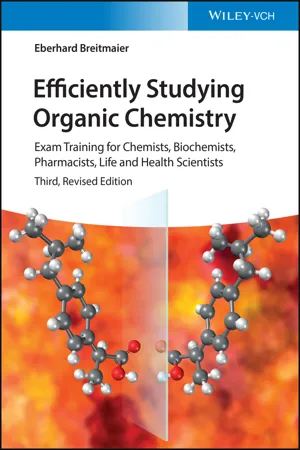
eBook - PDF
Efficiently Studying Organic Chemistry
Exam Training for Chemists, Biochemists, Pharmacists, Life and Health Scientists
Eberhard Breitmaier
This is a test
- English
- PDF
- Available on iOS & Android
eBook - PDF
Efficiently Studying Organic Chemistry
Exam Training for Chemists, Biochemists, Pharmacists, Life and Health Scientists
Eberhard Breitmaier
Book details
Table of contents
Citations
About This Book
Efficiently Studying Organic Chemistry
Complete yet concise learning resource for organic chemistry exam training
Based on the author's extensive teaching experience, this unique textbook comprises the essentials of organic chemistry in 86 chapters as concise, self-contained units of study. Each chapter, visually presented as one or two double pages, includes questions to allow for immediate and effective self-examination. Answers are summarized in the appendix.
Topics covered within the book include:
- Basic concepts (atomic and molecular orbitals, covalent bonding, hybridization, resonance, aromaticity)
- Molecular structure (atom connectivity, skeletal isomerism, conformation, configuration, chirality)
- The classes of organic compounds including natural products, polymers, and biopolymers
- Types, mechanisms, selectivity, and specificity of organic reactions
- Molecular structure elucidation (mass spectrometry, UV and visible light absorption, IR and NMR spectroscopy)
- Planning organic syntheses
The perfect fit for bachelor and master students alike, this book is an all-in-one resource for efficiently studying and passing organic chemistry exams.
Frequently asked questions
How do I cancel my subscription?
Can/how do I download books?
At the moment all of our mobile-responsive ePub books are available to download via the app. Most of our PDFs are also available to download and we're working on making the final remaining ones downloadable now. Learn more here.
What is the difference between the pricing plans?
Both plans give you full access to the library and all of Perlego’s features. The only differences are the price and subscription period: With the annual plan you’ll save around 30% compared to 12 months on the monthly plan.
What is Perlego?
We are an online textbook subscription service, where you can get access to an entire online library for less than the price of a single book per month. With over 1 million books across 1000+ topics, we’ve got you covered! Learn more here.
Do you support text-to-speech?
Look out for the read-aloud symbol on your next book to see if you can listen to it. The read-aloud tool reads text aloud for you, highlighting the text as it is being read. You can pause it, speed it up and slow it down. Learn more here.
Is Efficiently Studying Organic Chemistry an online PDF/ePUB?
Yes, you can access Efficiently Studying Organic Chemistry by Eberhard Breitmaier in PDF and/or ePUB format, as well as other popular books in Sciences physiques & Chimie organique. We have over one million books available in our catalogue for you to explore.
Information
Table of contents
- Cover
- Title Page
- Copyright
- Contents
- Preface
- Organic Chemistry
- 1 Atomic Orbitals, Electronic Configurations
- 2 Covalent Bonding
- 3 Hybridization of Atomic Orbitals
- 4 Covalent Carbon-Carbon Bonding
- 5 Alkanes
- 6 Skeletal Structure, Structural Isomerism
- 7 Basic Rules of Nomenclature
- 8 Drawing Molecular Structures
- 9 Conformation
- 10 Reactive Intermediates
- 11 Basic Types of Organic Reactions
- 12 Energy Turnover of Chemical Reactions
- 13 Radical Substitution
- 14 Alkenes, Skeletal and Configurational Isomers
- 15 Synthesis of Alkenes
- 16 Additions to Alkenes
- 17 Dienes
- 18 Additions and Cycloadditions with 1,3-Dienes
- 19 Alkynes
- 20 Cycloalkanes
- 21 Basic Syntheses of Cycloalkanes and Cycloalkenes
- 22 Reactions of Cycloalkanes and Cycloalkenes
- 23 Benzene, Aromaticity, Aromatic Compounds
- 24 Benzenoid Aromatic Compounds
- 25 Electrophilic Substitution of Benzene
- 26 Electrophilic Second Substitution of Benzenes
- 27 Other Reactions of Benzenoid Aromatics
- 28 Polycyclic Benzenoid Aromatic Compounds
- 29 Non-benzenoid Aromatic Compounds
- 30 Alkyl Halides
- 31 Mechanisms of Nucleophilic Substitution
- 32 Organometal Compounds
- 33 Alcohols
- 34 Diols, Triols
- 35 Reactions of Alcohols
- 36 Dehydration of Alcohols
- 37 Ethers
- 38 Amines
- 39 Reactions of Amines
- 40 Diazo and Azo Compounds
- 41 Carboxylic Acids
- 42 Carboxylic Acid Derivatives
- 43 Substituted Carboxylic Acids
- 44 Absolute Configuration
- 45 Enantiomers without Carbon as Stereogenic Center
- 46 Diastereomers
- 47 Aldehydes
- 48 Ketones
- 49 Carbonyl Reactions
- 50 CH Acidity of Carbonyl Compounds
- 51 1,3-Dicarbonyl Compounds
- 52 Phenols
- 53 Quinones
- 54 Organosulfur Compounds
- 55 Carbonic Acid Derivatives
- 56 Heterocumulenes
- 57 Rearrangements
- 58 Polymers, Polymerization
- 59 Syntheses with Organosilicon Compounds
- 60 Heteroalicycles
- 61 Five-Membered Aromatic Heterocycles
- 62 Six-Membered Aromatic Heterocycles
- 63 Benzo-Fused Five-Membered Heteroaromatics
- 64 Benzo-Fused Six-Membered Heteroaromatics
- 65 Fused Aromatic Heterocycles
- 66 Absorption of Light, Color, Dyes
- 67 Porphyrinoids
- 68 Amino Acids
- 69 Peptides, Proteins
- 70 Alkaloids
- 71 Carbohydrates: Aldoses and Ketoses
- 72 Carbohydrates: Oligo- and Polysaccharides
- 73 Nucleic Acids: DNA and RNA
- 74 Lipids
- 75 Polyketides
- 76 Terpenes
- 77 Steroids
- 78 Selectivity and Specificity of Organic Reactions
- 79 Prochirality, Enantioselectivity
- 80 Planning Organic Syntheses
- 81 Aspects of Molecular Structure
- 82 Mass Spectrometry
- 83 Infrared Spectroscopy
- 84 Nuclear Magnetic Resonance: Proton NMR
- 85 Nuclear Magnetic Resonance: Carbon-13 NMR
- 86 Nuclear Magnetic Resonance: Two-Dimensional NMR 248
- Working on Questions
- Subject Index
- Periodic Table of the Elements
- Selected Reference Sources
- EULA
Citation styles for Efficiently Studying Organic Chemistry
APA 6 Citation
Breitmaier, E. (2022). Efficiently Studying Organic Chemistry (3rd ed.). Wiley-VCH. Retrieved from https://www.perlego.com/book/3863097 (Original work published 2022)
Chicago Citation
Breitmaier, Eberhard. (2022) 2022. Efficiently Studying Organic Chemistry. 3rd ed. Wiley-VCH. https://www.perlego.com/book/3863097.
Harvard Citation
Breitmaier, E. (2022) Efficiently Studying Organic Chemistry. 3rd edn. Wiley-VCH. Available at: https://www.perlego.com/book/3863097 (Accessed: 26 June 2024).
MLA 7 Citation
Breitmaier, Eberhard. Efficiently Studying Organic Chemistry. 3rd ed. Wiley-VCH, 2022. Web. 26 June 2024.